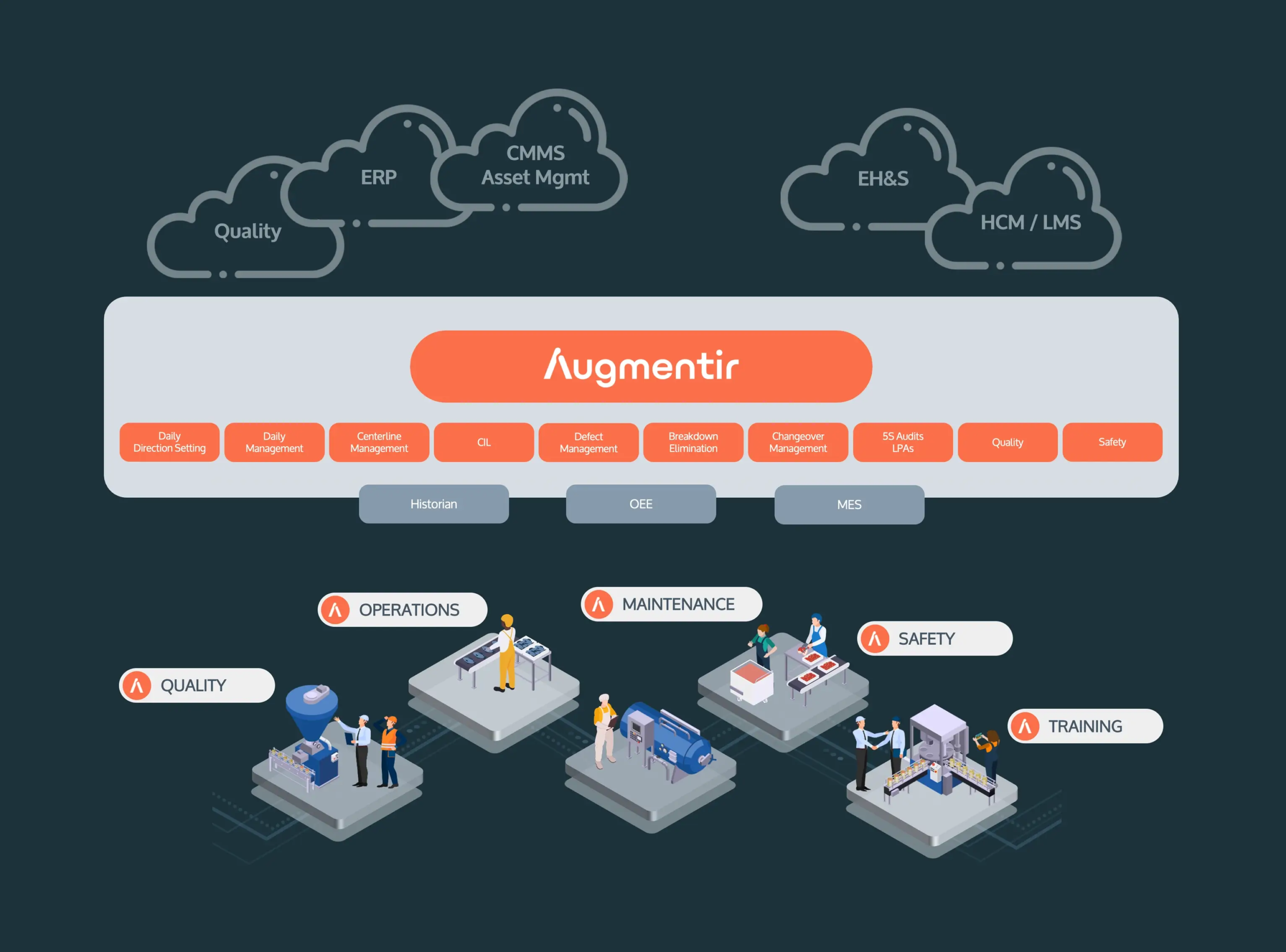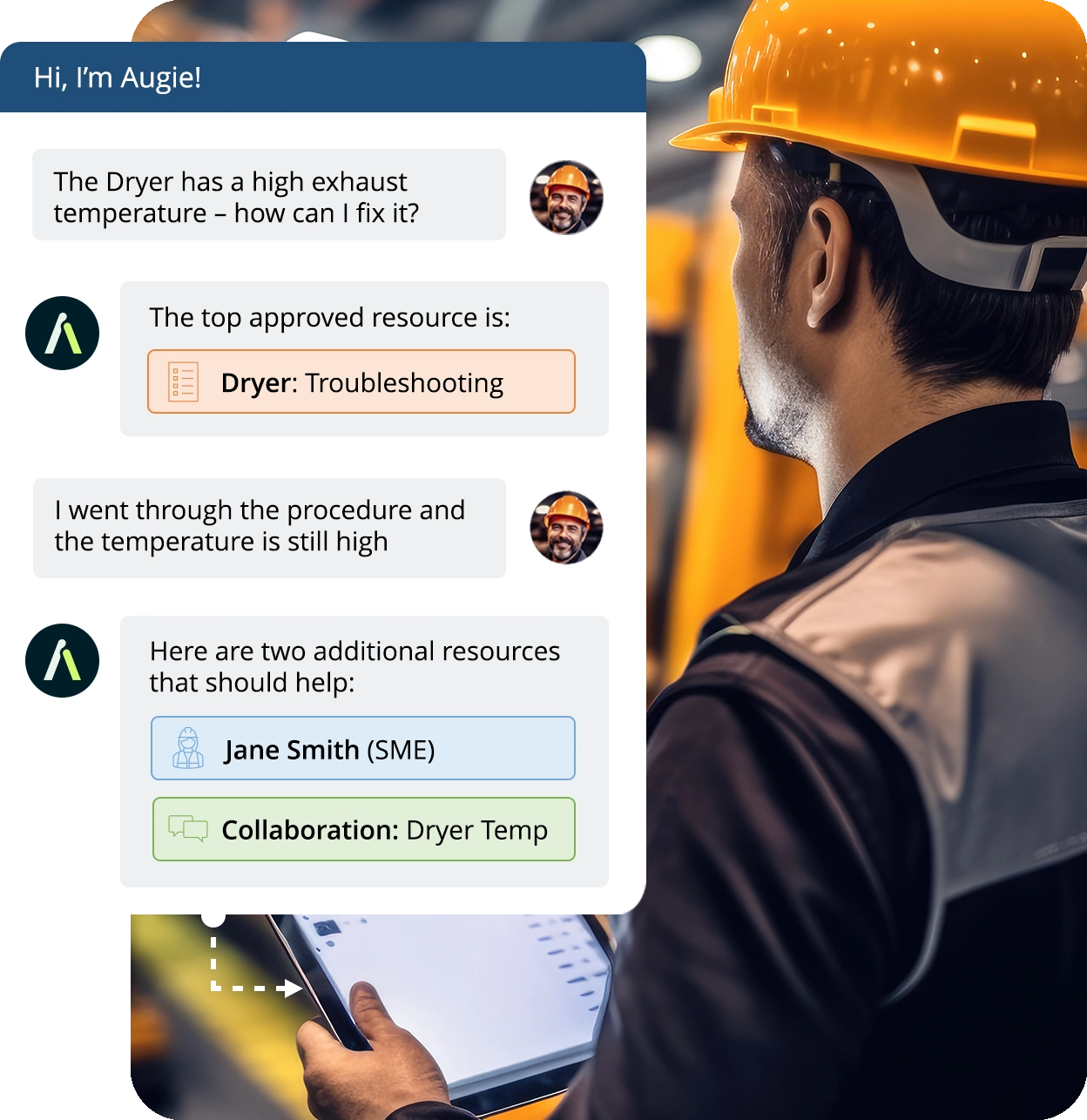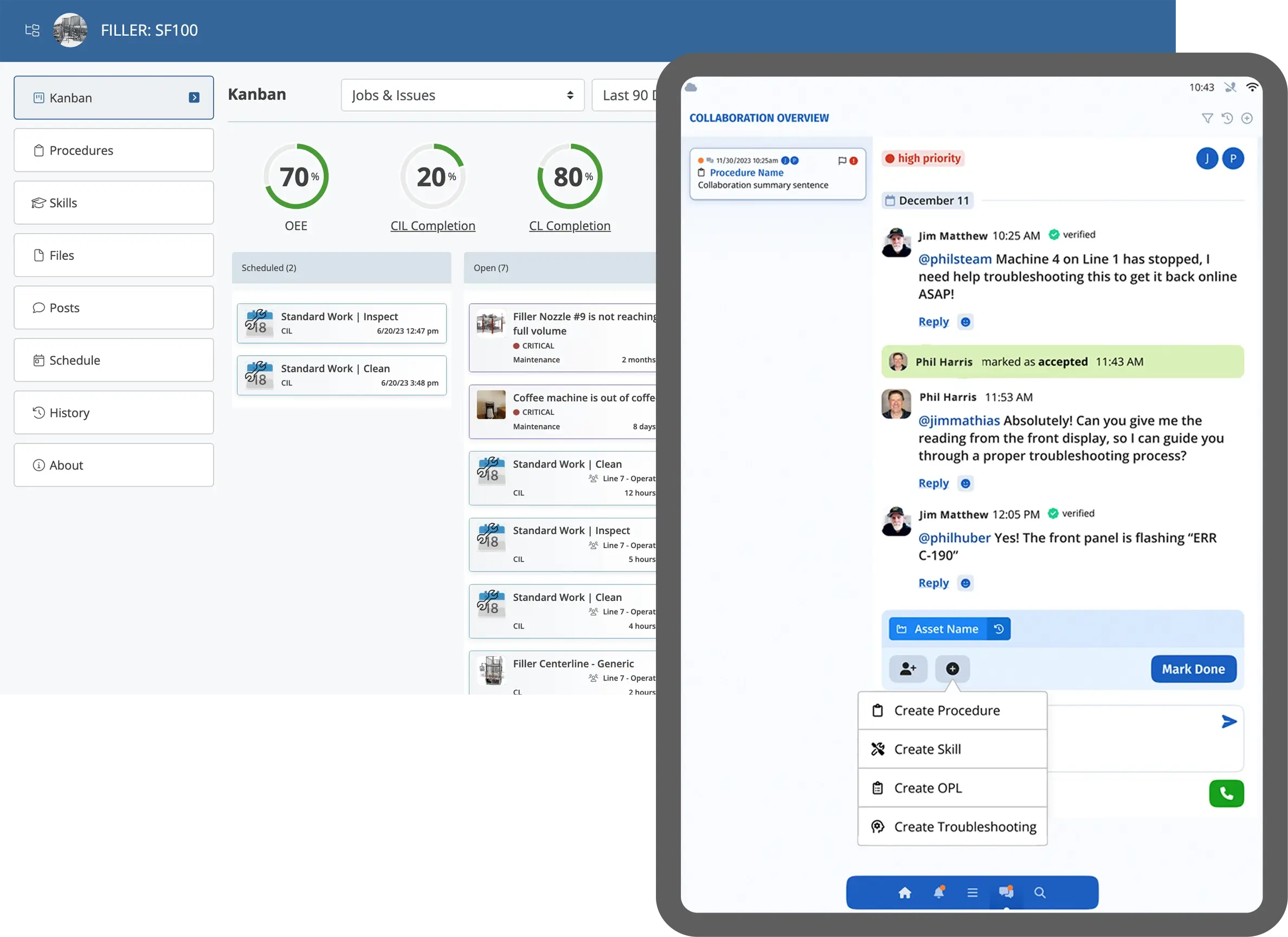Learn how connected worker technology helps eliminate breakdowns in manufacturing, boosting uptime, efficiency, and operational resilience.
Breakdowns are one of the most significant disruptors in manufacturing operations. Whether caused by mechanical failure, human error, or insufficient maintenance, equipment breakdowns lead to unplanned downtime, lost productivity, and increased operational costs. For manufacturers striving for world-class performance, Breakdown Elimination (BDE) is a foundational pillar of reliability-centered maintenance and operational excellence.
In this article, we explore what Breakdown Elimination entails, how Connected Worker technology transforms the approach to managing breakdowns, and how innovative platforms like Augmentir empower frontline teams to drive sustainable improvements.
What is Breakdown Elimination?
Breakdown Elimination is a proactive approach focused on identifying, analyzing, and permanently eliminating the root causes of equipment failures. It is a cornerstone of Total Productive Maintenance (TPM) and Lean Manufacturing, targeting improved Overall Equipment Effectiveness (OEE) through systematic problem-solving and process improvement.
Breakdown elimination directly tackles unplanned stops—one of the Six Big Losses in manufacturing—by reducing equipment failures and boosting uptime. Japanese entrepreneur Seiichi Nakajima developed both TPM and the six big losses as a framework for reducing waste and bringing more value to the customer. Eliminating breakdowns improves availability and helps address other losses tied to performance and quality, making it a key driver of overall efficiency.
Unlike reactive maintenance, where the focus is on fixing machines after failure, BDE emphasizes:
- Root cause analysis (RCA) to understand underlying issues
- Frontline involvement in identifying and solving problems
- Continuous improvement cycles to prevent recurrence
- Standardized work to sustain gains
The goal is not only to restore functionality but also to implement corrective and preventive actions that stop the problem from reoccurring. Successful BDE programs often involve cross-functional collaboration between operators, maintenance teams, engineers, and management.
Using digital tools and connected worker technology can help to support Breakdown Elimination at every stage—from detection to resolution and long-term prevention.
The Impact of Breakdown Elimination
Breakdown Elimination drives significant value across manufacturing operations, including:
- Reduced downtime: Identifying and resolving systemic causes of failure increases equipment availability
- Increased productivity: With more reliable assets, output levels rise without added costs.
- Lower maintenance costs: Preventing breakdowns reduces emergency repairs, spare part usage, and overtime.
- Improved safety: Eliminating frequent equipment failures reduces the risk of accidents and injuries.
- Better workforce engagement: Empowering frontline workers to solve problems promotes ownership and morale.
Despite its benefits, BDE can be challenging to implement without the right tools. Traditional paper-based systems often slow down data collection, obscure visibility into recurring issues, and hinder real-time collaboration.
Connected Worker Technology and Breakdown Elimination
Enter Connected Worker technology—digital platforms that empower frontline workers with real-time access to information, guidance, and collaboration tools. Connected Worker solutions play a transformative role in enabling Breakdown Elimination by addressing several critical needs in the process:
1. Real-time Data Collection
Connected Worker platforms allow operators and technicians to digitally log breakdown events as they occur. This immediate input ensures that data is accurate, timestamped, and enriched with contextual details (such as photos, sensor data, or video clips), which are crucial for effective root cause analysis.
2. Guided Workflows and Standardization
Digital work instructions and SOPs help standardize responses to breakdowns. When an operator encounters a recurring issue, they can follow an optimized troubleshooting guide, reducing variability and guesswork.
3. Enhanced Communication and Collaboration
Connected Worker tools support real-time communication across departments and shifts. Maintenance teams can be instantly alerted, engineers can review breakdown trends remotely, and best practices can be shared across sites.
4. Analytics and Continuous Improvement
With integrated analytics, Connected Worker platforms enable manufacturers to identify patterns in breakdown data. Heatmaps, Pareto charts, and KPI dashboards highlight systemic issues and help prioritize high-impact improvements.
5. Frontline Empowerment
Operators are no longer passive reporters of problems; they become active participants in problem-solving. Through digital forms, escalation tools, and feedback loops, workers contribute to eliminating the causes of breakdowns permanently.
How Augmentir Supports Breakdown Elimination
Augmentir, a leading Connected Worker platform powered by artificial intelligence (AI), provides a comprehensive suite of tools designed to support Breakdown Elimination at every stage—from detection to resolution and long-term prevention.
Augmentir serves as a digital frontline operating system for your TPM strategy. With Augmentir, you can digitize, manage, and optimize all aspects of your frontline operation:
- Daily Direction Setting (DDS)
- Daily Management System (DMS)
- Centerline Management
- Clean, Inspect, Lubricate processes
- Defect Management
- Breakdown Elimination
- Changeover Management
- Shift Handover
- 5S and Layered Process Audits
- Quality Management on the Shop Floor
- Safety
Here’s how Augmentir helps manufacturers eliminate breakdowns:
1. AI-Driven Work Instruction and Guidance
Augmentir’s digital workflows guide workers through inspection, troubleshooting, and maintenance procedures with step-by-step clarity. By digitizing standard operating procedures and enabling smart branching logic, Augmentir ensures the right action is taken at the right time—every time.
When equipment fails, operators can quickly access contextual work instructions based on the specific failure mode, reducing diagnosis time and improving repair accuracy.
Furthermore, with tools like Augmentir’s Augie – a generative AI assistant for frontline operations, operators can get access to real-time troubleshooting resources and digital guidance.
2. Smart Data Capture
Augmentir enables seamless data capture at the point of work. Operators log downtime events, causes, and corrective actions via mobile devices, tablets, or smart glasses. This data feeds directly into analytics dashboards without manual entry or delays.
Photo and video capture further enriches the data set, providing visual evidence that aids in root cause analysis and training.
3. Continuous Learning with AI Insights
The AI engine in Augmentir analyzes performance data from workers, machines, and processes to identify skill gaps, process inefficiencies, and frequent failure patterns. These insights help prioritize BDE efforts and guide targeted interventions.
For example, if a particular asset experiences frequent minor stops due to operator error, Augmentir can recommend personalized training or suggest procedural adjustments.
4. Cross-Functional Collaboration
Breakdown Elimination often requires input from multiple departments. Augmentir fosters collaboration by enabling real-time communication and task delegation within a single platform. Issues can be escalated, tracked, and resolved collaboratively, reducing mean time to repair (MTTR).
5. Knowledge Retention and Transfer
Breakdown Elimination requires that lessons learned are captured and shared. Augmentir creates a living knowledge base where best practices, successful fixes, and RCA findings can be stored and retrieved on demand. New hires benefit from instant access to tribal knowledge, improving ramp-up time and reducing repeated failures.
Contact us today for a live demo.




